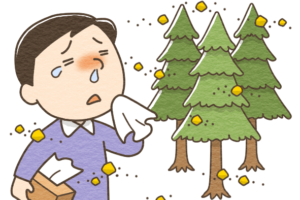【Contents】
- About Pollen Allergy
- Learning about pollen allergy
- Learning about symptoms of hay fever
- Learning about treatments for pollen allergy
- When seeing a doctor for pollen allergy
- What you can do to prevent pollen allergy
- Self-care when going outside
- Self-care at home
1.About Pollen Allergy
This section provides information about pollen allergy based on “Pollen Allergy Special(花粉症特集),” the feature covering pollen allergy on the Ministry of Health, Labour and Welfare website. (Part of the content has been edited.)
<Learning about pollen allergy>
Pollen allergy, characterized by symptoms of hay fever or allergic rhinitis, is a type of allergic diseases caused when pollen acts as an allergen (an allergy-causing substance).
A wide variety of plants cause hay fever, and about 50 types of plants have been reported as allergy triggers in Japan. The most common type is Japanese cedar, which is said to account for about 70% of all pollen-induced allergy cases.
Pollen counts and seasons vary from region to region. For example, very little Japanese cedar pollen flies around in Hokkaido, while a lot of cypress pollen is dispersed in Yamanashi Prefecture.
Pollen Calendar of Kanto Region
The pollen calendar has been edited and created based on the following source:
MSD “Pollen Now: Pollen Allergy/Allergic Rhinitis Information Site
(花粉なう 花粉症・アレルギー性鼻炎情報サイト)”
http://www.kafun-now.com/knowledge/01.xhtml
Japanese Cedar
<Learning about symptoms of hay fever>
Symptoms of hay fever appear mainly in the nose and the eyes. Some people develop symptoms as soon as pollen starts flying around, while others do not develop symptoms until pollen is dispersed in large quantities.
In severe cases, symptoms may include low-grade fever, fatigue, itchy skin, itchy throat, and other systemic symptoms.
Main symptoms of hay fever
<Learning about treatments for pollen allergy>
Although it is impossible to completely avoid or remove pollen in daily life, it is necessary to take measures to keep pollen from entering the body as much as possible in order to prevent symptoms from worsening and quality of life from deteriorating.
There are two main types of treatment for pollen allergy: symptomatic treatment, which aims to alleviate symptoms, and curative treatment, which aims to cure a disease.
What is symptomatic treatment for pollen allergy (hay fever)?
- Topical treatment with eye drops, nasal sprays, etc.
- Systemic treatment through oral medications, etc.
- Surgical treatment such as laser therapy
The common medications used in symptomatic treatment include the following:
- Antihistamines…They are often used when sneezing and runny nose are the main symptoms.
- Steroid nasal sprays…They are often used when stuffy nose is the main symptom and are also effective against sneezing and runny nose.
What is curative treatment for pollen allergy?
Especially for patients with severe cases, curative treatment targeting the cause(s) of pollen allergy may be conducted concomitantly with symptomatic treatment.
The common form of curative treatment is “hyposensitization therapy.” In this therapy, low concentrations of pollen extracts are administered at first, and then, the concentrations are gradually increased to develop immunity to pollen allergens. This treatment needs to be continued for at least two years.
About timing to start treatment
For patients who experience severe symptoms every year, preseasonal treatment is effective. Preseasonal treatment is the treatment method in which drug therapy is conducted as soon as pollen starts flying around, or as soon as symptoms start appearing.
It is advisable to take measures when you feel symptoms even a little, not after symptoms become severe.
2.When seeing a doctor for pollen allergy
Diagnosis of pollen allergy (hay fever)
In the diagnosis of hay fever or allergic rhinitis caused by such allergies as pollen allergy, it is necessary to be differentiated from acute rhinitis and acute/chronic sinusitis caused by common cold.
If a patient has the three nasal symptoms, itchy nose/sneezing, runny nose, and stuffy nose, and tests positive, the patient is highly likely to have pollen allergy. In addition, a medical interview will be conducted, and a diagnosis will be made comprehensively.
About types of doctors to see
If you have severe nasal symptoms, consider consulting an otolaryngologist—an ear, nose, and throat (ENT) doctor—and if you have severe eye symptoms, consider seeing an ophthalmologist—an eye doctor.
Internal medicine physicians, pediatricians, and allergists are also options.
3.What you can do to prevent pollen allergy
In addition to receiving treatment from a doctor, self-care can also prevent symptoms from worsening.
<Self-care when going outside>
Wear glasses, a mask, and a hat!
Wearing glasses and a mask can reduce the number of pollen grains entering your nose and eyes to fewer than half compared to the number when you do not wear them.
If you wear contact lenses, it is recommended that you switch to glasses at least during pollen seasons, because pollen rubs between the lenses and the conjunctiva.
When using a commercially available mask, it is effective to insert damp gauze under the mask.
Avoid wearing wool clothing!
Avoid wearing wool clothing as much as possible, because pollen tends to stick to it and you can bring pollen inside.
Make sure you wash your hands and gargle!
Before entering your home, shake off pollen from your outerwear at the door. It is also recommended to wash your face along with handwashing and gargling.
<Self-care at home>
Don’t open windows and hang laundry and bedding out to dry on days when the large amount of pollen is dispersed!
Shake out your laundry well before you bring it inside!
Avoid anything that could damage your mucous membranes (cigarette smoke, etc.)!
Keep healthy daily routines, and manage stress!
・The above content refers to information from the sources listed below. Please note that if there are changes in the information on the reference sources, it may take some time before those changes are reflected on this site.
【Sources】
・Ministry of Health, Labour, and Welfare “Pollen Allergy Special (花粉症特集)”
・Ministry of Health, Labour, and Welfare “Proper Knowledge of Pollen Allergy and Its Treatment/Self-care (花粉症の正しい知識と治療・セルフケア)”
・MSD “Pollen Now: Pollen Allergy/Allergic Rhinitis Information Site (花粉なう 花粉症・アレルギー性鼻炎情報サイト)”













